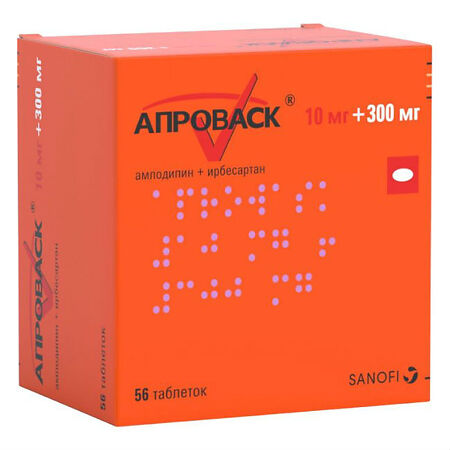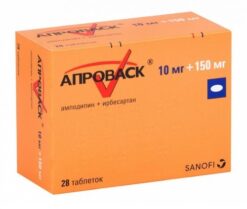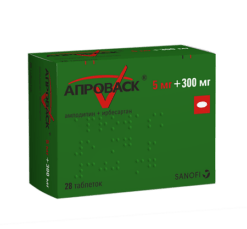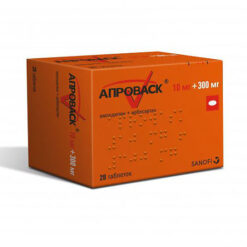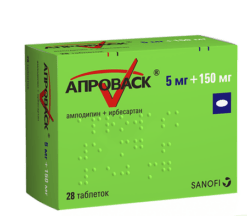No products in the cart.
Aprovask, 10 mg+300 mg 56 pcs
€1.00
Out of stock
(E-mail when Stock is available)
Description
A combined antihypertensive drug. The pharmacodynamic properties of each of the active ingredients in Aprovask®, irbesartan and amlodipine contribute to their additive antihypertensive effects when used in combination compared to when each drug is used alone.
Angiotensin II receptor antagonists (ARA II) and slow calcium channel blockers both decrease BP by reducing peripheral vascular resistance, the blockade of calcium entry into the cell and the reduction of angiotensin II-induced vasoconstrictor action are complementary mechanisms.
Irbesartan
Irbesartan is a selective potent ARA II (subtype AT1). Angiotensin II is an important component of the RAAS involved in the pathophysiology of arterial hypertension and in sodium ion homeostasis. Irbesartan does not require metabolic activation to manifest its action.
Irbesartan blocks the potent vasoconstrictor and aldosterone-secreting actions of angiotensin II through selective antagonism to angiotensin II receptors (subtype-AT1) located in vascular smooth muscle cells and adrenal cortex.
Irbesartan has no agonist activity toward AT1 receptors. Its affinity for AT1 receptors is 8,500 times greater than that for AT2 receptors (receptors that have not been shown to be associated with cardiovascular equilibrium [homeostasis] maintenance).
Irbesartan does not inhibit RAAS enzymes (such as renin, ACE) and does not affect other hormone receptors or ion channels in the cardiovascular system involved in the regulation of BP and sodium ion homeostasis. Blockade of AT1 receptors by irbesartan breaks the feedback loop in the renin-angiotensin system, increasing plasma concentrations of renin and angiotensin II.
The use of irbesartan decreases plasma concentrations of aldosterone, but there is no significant change in serum potassium when the drug is used at recommended doses (average increase in serum potassium is less than 0.1 mEq/L). Irbesartan has no significant effect on serum triglyceride, cholesterol or glucose concentrations.
Irbesartan has no effect on serum concentrations of uric acid or renal excretion of uric acid.
The antihypertensive effect of irbesartan develops after the first dose and becomes significant within 1-2 weeks of treatment with maximal effect occurring after 4-6 weeks. In long-term observational studies, the effect of irbesartan persisted for more than 1 year.
Single administration of irbesartan in doses up to 900 mg/day caused a dose-dependent decrease in BP. A single dose of irbesartan 150-300 mg/day resulted in greater systolic (SBP)/diastolic (BP) decrease (24 hours after the dose) in the supine or sitting position (on average 8-13/5-8 mmHg) than placebo. The drug effect 24 h after the dose was 60-70% of the corresponding maximum reduction of BP and BP. Optimal efficacy with respect to 24-hour BP reduction is achieved with a single daily dose of the drug.
The BP decreases approximately equally in standing and lying position. Orthostatic effect is rare, and as with ACE inhibitors, its occurrence may be expected in patients with hyponatremia or hypovolemia.
The antihypertensive effects of irbesartan and thiazide diuretics are additive. In patients who do not achieve target BP values with irbesartan monotherapy, adding small doses of hydrochlorothiazide (12.5 mg) once daily to irbesartan causes an additional (compared to the effect of adding placebo) 7-10/3-6 mm Hg decrease in BP/DP, 24 hours after administration, respectively.
Age and gender have no effect on the efficacy of irbesartan. As with treatment with other drugs that affect the RAAS, a weaker antihypertensive effect is observed in non-Hispanic patients on irbesartan monotherapy. When irbesartan is taken with low-dose hydrochlorothiazide (e.g., 12.5 mg/day), the antihypertensive effect in non-Hispanic patients is similar to that in Caucasian patients.
After discontinuation of irbesartan, BP gradually returns to baseline. No withdrawal syndrome has been observed with discontinuation of irbesartan.
Amlodipine
Amlodipine is a slow calcium channel blocker from the group of dihydropyridine derivatives, which inhibits transmembrane entry of calcium ions into myocardial and vascular smooth muscle cells. The mechanism of antihypertensive action of amlodipine is associated with direct relaxant action on vascular smooth muscle.
The exact mechanism by which amlodipine reduces the frequency and severity of angina attacks is not fully established, but amlodipine reduces myocardial ischemia due to the following two effects.
1) Amlodipine dilates the peripheral arterioles and thereby reduces ROS, the so-called afterload. Because heart rate does not increase significantly when taking amlodipine, this decrease in cardiac output reduces myocardial energy expenditure and myocardial oxygen demand.
2) The mechanism of antianginal action of amlodipine also appears to be related to the dilation of the main coronary arteries and coronary arterioles, both in areas of myocardium with normal blood flow and in ischemic areas of myocardium. This dilation of the coronary vessels increases oxygen delivery to the myocardium in patients with coronary artery spasm (in Prinzmetal or variant angina).
In patients with arterial hypertension, administration of amlodipine once daily provides clinically significant reduction of BP in lying and standing position for 24 hours. Because of the slow onset of action, amlodipine is not indicated for the management of hypertensive crises.
In patients with angina a single daily dose of amlodipine during exercise testing increases total time to exercise, time to onset of angina attack and time to ST-segment depression of 1 mm on ECG.
In addition, taking the drug reduces the daily number of angina attacks and the daily requirement for taking nitroglycerin tablets.
There have been no adverse metabolic effects or changes in blood lipid concentrations when taking amlodipine. Amlodipine can be administered to patients with bronchial asthma, diabetes mellitus and gout.
The clinical evidence for the efficacy of the fixed-dose combination of irbesartan and amlodipine came from two multicenter, prospective, open-label, parallel-group, blinded efficacy studies: the I-ADD and I-COMBINE studies. Results from both studies demonstrated significantly greater efficacy of fixed-dose combinations of irbesartan and amlodipine compared with amlodipine monotherapy or irbesartan monotherapy.
Indications
Indications
Active ingredient
Active ingredient
Composition
Composition
One 10 mg + 300 mg tablet contains:
The core:
active ingredients: amlodipine besylate – 14.0 mg (in terms of amlodipine – 10.0 mg), irbesartan – 300.0 mg;
excipients: microcrystalline cellulose 50 µm – 132.0 mg, croscarmellose sodium – 24.0 mg, hypromellose 6 mPa.c – 10.0 mg, microcrystalline cellulose 100 µm – 10.0 mg, silicon dioxide – 5.0 mg, magnesium stearate – 5.0 mg;
coating: opadray white1 – 20.0 mg.
1 – Opadray white contains hypromellose – 62.50%, titanium dioxide (E 171) – 31.25%, macrogol-400 – 6.25%.
.
How to take, the dosage
How to take, the dosage
Normally, the starting and maintenance dose of Aprovask® is 1 tablet a day.
The drug Aprovasc® should be used in patients in whom BP targets are not achieved with irbesartan monotherapy or amlodipine monotherapy, or to continue treatment of patients already taking irbesartan and amlodipine as single tablets.
The doses must be adjusted individually, initially with separate irbesartan and amlodipine preparations. Doses are adjusted according to BP response to therapy and target BP.
The maximum recommended dose of Aprovask® is 150 mg/10 mg or 300 mg/10 mg daily (due to the fact that the maximum daily dose of amlodipine is 10 mg).
In children
The safety and effectiveness of Aprovask® have not been established.
Patients in the elderly and patients with impaired renal function
There is usually no need for dose reduction in elderly patients (see section “Pharmacodynamics”) and patients with impaired renal function.
Patients with impaired hepatic function
Aprovasc® should be used with caution due to the presence of amlodipine in the drug (see “Caution” and “Cautionary Note” sections).
Interaction
Interaction
There have been no studies on drug interactions of Aprovasc® with other medicinal products.
Irbesartan
Based on these in vitro studies, no interactions should be expected with drugs whose metabolism is performed by the following cytochrome P450 isoenzymes: CYP1A1, CYP1A2, CYP2A6, CYP2B6, CYP2D6, CYP2E1 or CYP3A4.
Irbesartan is primarily metabolized by the CYP2C9 isoenzyme, but no significant pharmacokinetic interactions were observed in clinical interaction studies when irbesartan was taken concomitantly with warfarin, which is metabolized by the CYP2C9 isoenzyme.
The pharmacokinetic parameters of irbesartan are not impaired by its concomitant use with nifedipine and hydrochlorothiazide.
Irbesartan does not alter the pharmacokinetics of simvastatin, which is metabolized by the CYP3A4 isoenzyme, or digoxin (P-glycoprotein substrate).
Combination of Aprovask with drugs containing aliskiren is contraindicated in patients with diabetes mellitus or moderate to severe renal insufficiency (FFR less than 60 ml/min/1.73 m2 body surface area) and is not recommended in other patients. ACE inhibitors: The use of Aprovasc® in combination with ACEs is contraindicated in patients with diabetic nephropathy and is not recommended for other patients.
Based on experience with other drugs that affect the RAAS, concomitant use of irbesartan with potassium preparations: potassium containing salt substitutes; potassium saving diuretics or other drugs that can increase plasma potassium (heparin) can sometimes significantly increase serum potassium levels, which requires close monitoring of plasma potassium levels in patients during treatment.
In elderly patients, patients with hypovolemia (due to diuretics) or with impaired renal function, concomitant use of nonsteroidal anti-inflammatory drugs (NSAIDs), including selective cyclooxygenase-2 inhibitors (COX-2) together with APAII, including irbesartan, may lead to worsening of renal function, including development of acute renal failure. These effects are usually reversible. Renal function should be periodically monitored in patients concomitantly taking APAII and NSAIDs, including COX-2 selective inhibitors.
Lithium: during coadministration of irbesartan with lithium preparations an increase in plasma lithium concentrations and toxic effects of lithium have been described. Plasma lithium concentrations should be monitored in patients taking irbesartan concomitantly with lithium preparations.
Amlodipine
Amlodipine has been safely combined with thiazide diuretics, beta-adrenoblockers, alpha-adrenoblockers, ACE inhibitors, long-acting nitrates, nitroglycerin for sublingual use, NSAIDs, antibiotics and hypoglycemic agents for oral administration.
In vitro studies with human plasma have shown that amlodipine does not affect the protein binding of digoxin. phenytoin, warfarin or indomethacin.
Cimetidine: concomitant administration of amlodipine and cimetidine did not interfere with the pharmacokinetics of amlodipine.
Grapefruit juice: concomitant ingestion of 240 mg grapefruit juice with one dose of amlodipine 10 mg in 20 healthy volunteers had no significant effect on amlodipine pharmacokinetics.
Sildenafil: When amlodipine and sildenafil were used concomitantly, each drug had an independent antihypertensive effect.
Atorvastatin: concomitant administration of amlodipine at a dose of 10 mg and atorvastatin at a dose of 80 mg resulted in non-significant changes in pharmacokinetic parameters of atorvastatin in Css achievement state.
Digoxin: Concomitant administration of amlodipine with digoxin did not alter the serum digoxin concentration or renal clearance of digoxin in healthy volunteers.
Warfarin: concomitant administration of amlodipine and did not alter prothrombin time while taking warfarin.
Cyclosporine: Pharmacokinetic studies with cyclosporine have demonstrated that amlodipine has no significant effect on the pharmacokinetics of cyclosporine.
Tacrolimus: Concomitant use of tacrolimus and amlodipine may increase tacrolimus plasma concentrations. Plasma concentrations of tacrolimus should be monitored and the dose should be adjusted if necessary.
Simvastatin: concomitant use of amlodipine with simvastatin may increase the exposure of simvastatin compared to simvastatin monotherapy. When concomitant use of simvastatin and amlodipine it is necessary to limit the daily dose of simvastatin to 20 mg.
Special Instructions
Special Instructions
Patients with chronic heart failure
Patients with chronic heart failure In a long-term placebo-controlled trial (PRAISE-2) of amlodipine in patients with chronic heart failure of functional class III-IV (NYHA classification) nonischemic etiology, amlodipine was associated with increased reports of pulmonary edema, despite no significant difference in the rate of heart failure progression compared with placebo.
Help failure
As with other slow calcium channel blockers. The T1/2 of amlodipine is increased in patients with hepatic impairment, and there are no recommendations for its dosing regimen in hepatic impairment. Therefore, the drug Aprovasc® should be used with caution in these patients.
Hypertensive crisis
The safety and effectiveness of Aprovasc® in hypertensive crisis have not been established.
Impact on renal function
Inhibition of the RAAS can be expected to result in changes in renal function in predisposed patients.
In patients whose renal function depends on RAAS activity (patients with arterial hypertension with renal artery stenosis of one or both kidneys or patients with chronic heart failure of functional class III-IV (according to NYHA classification), treatment with other drugs that affect RAAS has been associated with the development of oliguria and/or progressive azotemia and rarely with acute renal failure and/or death.
The possibility of this effect can not be excluded with the use of ARASII, including irbesartan.
The use in elderly patients
In patients who have taken irbesartan in clinical trials, no difference in efficacy or safety of irbesartan was observed in elderly patients (65 years and older) compared to younger patients.
The use in children
The safety and efficacy in children have not been established at this time.
Double RAAS blockade when Aprovasc® is combined with drugs containing aliskiren and with angiotensin-converting enzyme inhibitors.
Twice blockade of the RAAS when combining Aprovask® with ACEs or aliskiren is recommended because there is an increased risk of BP abruption, hyyercalemia, and renal dysfunction.
In patients with diabetes mellitus or moderate to severe renal impairment (with a GFR of < 60 ml/min/1.73 m2 body surface area), the use of Aprovasc® in combination with aliskiren is contraindicated. In patients with diabetic nephropathy, the use of Aprovasc® in combination with ACEs is contraindicated.
The effect of the drug Aprovask® on the ability to drive vehicles or engage in other potentially dangerous activities
The effect of the drug Aprovask® on the ability to drive vehicles or engage in other potentially dangerous activities requiring increased attention has not been studied. However, based on its pharmacodynamic properties, the effect of Aprovask® on this ability is unlikely.
But if dizziness, vertigo, and weakness occur, it is not recommended to drive a vehicle or engage in other potentially hazardous activities.
Contraindications
Contraindications
Side effects
Side effects
The incidence of HFs reported during postmarketing use of the drug was defined as “incidence unknown” because these HFs came from spontaneous reports, without specifying the number of patients. taking the drug.
In clinical trials comparing fixed-dose irbesartan/amlodipine combinations with irbesartan or amlodipine monotherapy, the types and frequency of adverse events occurring during treatment, possibly related to the treatment studied, were similar to those observed in prior clinical trials or in postmarketing reports in irbesartan and amlodipine monotherapy. The most common adverse event was peripheral edema, mostly associated with amlodipine.
The adverse events observed during treatment and possibly related to the study drug in the irbesartan/amlodipine clinical trials (I-ADD, I-COMBINE, and I-COMBO)
Fixed irbesartan/amlodipine combination
General disorders and disorders at the site of administration
Often: Peripheral edema, swelling.
Infrequent: asthenia.
Hearing and labyrinth disorders
Infrequent: vertigo.
Cardiac disorders
Often: sensation of palpitations.
Infrequent: sinus bradycardia.
Nervous system disorders
Often: dizziness, headache, somnolence.
Infrequent: paresthesia.
Genital and breast disorders
Infrequent: erectile dysfunction.
Respiratory system, chest and mediastinum disorders
Infrequent: cough.
Vascular disorders
Often: orthostatic hypotension.
Infrequently: excessive lowering of BP.
Gastrointestinal tract disorders
Often: swollen gums.
Infrequently: nausea, upper abdominal pain, constipation.
Kidney and urinary tract disorders
Often: proteinuria.
Infrequent: azotemia, hypercreatininemia.
Disorders of metabolism and nutrition
Infrequent: hyperkalemia.
Muscular and connective tissue disorders
Infrequent: joint stiffness, arthralgia, myalgia.
Irbesartan adverse events observed with irbesartan in clinical trials (including the I-ADD, I-COMBINE and I-COMBO clinical trials) and in its post-marketing use
Immune system disorders
Frequency unknown: hypersensitivity reactions (allergic reactions).
Metabolic and nutritional disorders
Frequency unknown: hyperkalemia.
Hearing and labyrinth disorders
Often: vertigo.
Frequently unknown: tinnitus.
Nervous system disorders
Often: dizziness, headache*.
Infrequent: orthostatic vertigo.
The incidence of headache in the I-ADD, I-COMBINE and I-SOMBO studies was rated as “infrequent.”
Cardiac disorders
Infrequent: tachycardia.
Skin and subcutaneous tissue disorders
Frequency unknown: leukocytoclastic vasculitis.
Respiratory system, chest and mediastinum disorders
Infrequent: cough.
Gastrointestinal disorders
Often: nausea/vomiting, upper abdominal pain, tongue disorders, glossodynia (burning sensation and pain in the tongue).
Frequently unknown: dysgeusia (perversion of taste).
Infrequently: diarrhea, dyspepsia, heartburn.
Liver and biliary tract disorders
Frequent unknown: jaundice, increased liver function tests, hepatitis.
Skin and subcutaneous tissue disorders
Infrequent: alopecia.
Frequently unknown: angioedema, urticaria.
Muscular and connective tissue disorders
Frequently unknown: myalgia.
Kidney and urinary tract disorders
Frequency unknown: renal dysfunction, including individual cases of renal failure in patients with risk factors for its development.
Genital and breast disorders
Infrequent: erectile dysfunction.
General disorders and disorders at the site of administration
Frequent: increased fatigue*, swelling.
Infrequent: chest pain.
Frequent unknown: asthenia.
Injuries, intoxications, and complications of manipulation
Infrequent: falls.
Unwanted phenomena observed with amlodipine in clinical trials (including I-ADD, I-COMBINE and I-COMBO clinical trials)
Disorders of the blood and lymphatic system
Very rare: thrombocytopenia.
Immune system disorders
Very rare: allergic reactions.
Metabolic and nutrition disorders
Very rare: hyperglycemia.
Mental disorders
Infrequent: insomnia, mood swings.
Nervous system disorders
Often: dizziness, headache*, somnolence.
Infrequent: hypoesthesia, paresthesia, tremor, perversion of taste, syncopal states.
Very rare: peripheral neuropathy.
Visual disorders
Infrequent: visual disturbances.
Hearing and labyrinth disorders.
Infrequent: tinnitus, vertigo.
Cardiac disorders
Often: palpitations.
Very rare: myocardial infarction, heart rhythm disorders, ventricular tachycardia and atrial fibrillation (atrial fibrillation).
Vascular disorders
Often: “rushes” of blood to the skin with a feeling of heat, redness of the skin*.
Infrequent: excessive reduction of BP.
Very rare: vasculitis.
Respiratory system, thorax and mediastinum disorders
Often: cough.
Infrequent: dyspnea, rhinitis.
Very rare: coughing.
Digestive system disorders
Often: nausea, abdominal pain, glossodynia, glossitis.
Infrequent; dyspepsia, vomiting, changes in defecation rhythm, dry mouth mucosa.
Very rare: pancreatitis, gastritis, gum hyperplasia.
Liver and biliary tract disorders
Very rare: hepatitis, jaundice and increased activity of “liver” enzymes (mainly associated with cholestasis).
Skin and subcutaneous tissue disorders
Often: contact dermatitis.
Infrequent: skin rash, itching, purpura, increased sweating, changes in skin pigmentation (appearance of discolored areas of skin), alopecia.
Very rare: angioedema, erythema multiforme, urticaria.
Muscular and connective tissue disorders
Infrequent: arthralgia, muscle cramps, myalgia, back pain.
Kidney and urinary tract disorders
Infrequent: increased frequency of urination, painful urge to urinate, nicturia.
Gender and breast disorders
Infrequent: impotence, gynecomastia.
General disorders and disorders at the site of administration
Often: increased fatigue, edema*, peripheral edema.
Infrequent: chest pain, asthenia, malaise, pain.
Rarely: facial edema.
Laboratory and instrumental data
Infrequent: weight gain, weight loss.
Overdose
Overdose
In adults taking irbesartan at doses up to 900 mg per day, no toxicity has been established.
The available data for amlodipine suggest that severe overdose may result in marked peripheral vasodilation and possibly the development of reflex tachycardia. Severe and prolonged excessive BP lowering, up to and including development of shock with fatal outcome, has been reported.
Treatment
The patient must be under close medical supervision. Treatment should be symptomatic and supportive of basic vital body functions.
There is no specific information on the treatment of irbesartan overdose.
Proposed measures for Aprovask® overdose include gastric lavage. Administration of activated charcoal in healthy volunteers immediately after or 2 h after ingestion of 10 mg amlodipine showed a slight decrease in absorption of amlodipine.
Due to the fact that amlodipine is highly bound to blood proteins and irbesartan is not excreted by hemodialysis, it is unlikely that hemodialysis may be beneficial in overdose.
If a very large overdose has occurred, active cardiac and respiratory monitoring should be initiated. Frequent BP measurement is necessary. A clinically significant decrease in BP due to amlodipine overdose requires active cardiovascular support, including elevation of the extremities.
Circulating blood volume and urine output should be monitored. It may be necessary to administer vasoconstrictors to restore vascular tone and BP (if there are no contraindications for their administration). Intravenous administration of calcium gluconate may be useful in eliminating the consequences of calcium channel blockade.
Pregnancy use
Pregnancy use
Pregnancy
When irbesartan was administered at doses â¥50 mg/kg body weight/day (which, when converted to kg body weight, is approximately equivalent to the maximum recommended dose of irbesartan in humans [MRDICH] of 300 mg/day) in pregnant rats from day 0 to 20 gestation, transient effects (mild to moderate renal pelvis dilation, hydroureter and/or absence of renal papillae) were observed in rat fetuses.
When irbesartan was administered at doses ⥠180 mg/kg body weight/day (approximately equivalent to 4*MRDIH per kg body weight) to pregnant rats from day 0 to day 20 of gestation, the development of subcutaneous edema was observed in fetal rats.
Since these developmental abnormalities were not observed when irbesartan was restricted to oral doses of 50, 150, and 450 mg/kg body weight/day in pregnant rats from days 6 to 15 of gestation, they appear to be late gestational effects of irbesartan.
In rabbits, the use of irbesartan at a dose of 30 mg/kg body weight/day was associated with maternal mortality and abortion. Surviving females receiving this dose, equivalent to 1.5*MRDIH per kg body weight, had a slight increase in fetal resorption and a corresponding decrease in the number of live fetuses in the litter.
Irbesartan was found to penetrate the placental barrier in rats and rabbits. No teratogenic effects of amlodipine have been identified in rats and rabbits.
There are no sufficient and well-controlled studies on the use of Aprovasc® in pregnant women. Fetal exposure to ACE inhibitors taken by pregnant women in the second and third trimesters of pregnancy has resulted in damage and death to the developing fetus.
Like any other drugs that directly affect the RAAS, Aprovasc® is contraindicated during pregnancy.
Aprovasque® should not be used in women of childbearing potential unless they are using effective contraception. If pregnancy is detected during treatment with Aprovasc® , the drug should be discontinued as soon as possible (see section on Contraindications),
Breastfeeding
The drug Aprovasc® is contraindicated during breastfeeding (see section on Contraindications).
Additional information
| Shelf life | 3 years. |
|---|---|
| Conditions of storage | Store at temperatures under 30 ° C. Keep out of reach of children. |
| Manufacturer | Sanofi-Aventis de Mexico S.A. de S.V., Mexico |
| Medication form | pills |
| Brand | Sanofi-Aventis de Mexico S.A. de S.V. |
Other forms…
Related products
Buy Aprovask, 10 mg+300 mg 56 pcs with delivery to USA, UK, Europe and over 120 other countries.

